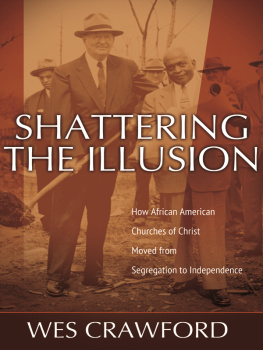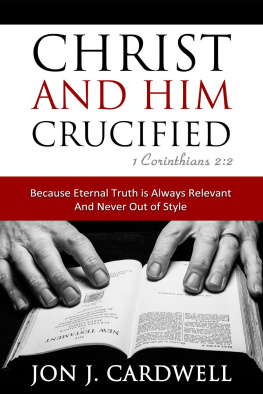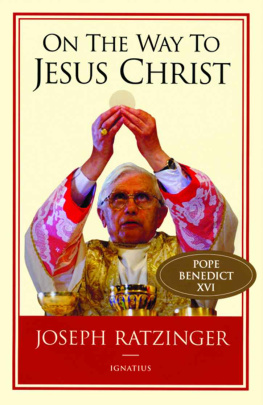PRAISE FORThe Color of Christ
Edward Blum and Paul Harveys masterful book is a breath of fresh air in our toxic religious culture of learned ignorance and unlearned bigotry.CORNEL WEST
In starkly poetic prose, this book takes a seemingly simple ideaexamine evolving depictions of Jesus in Americaand delivers punch after punch. Blum and Harvey provide a new, paradigm-changing window into the issues of race, religion, and power. Anyone wanting to grasp the depth of religion and race in the United States needs this book. It will transform what you thought you knew.MICHAEL O. EMERSON, Rice University, author of Divided by Faith: Evangelical Religion and the Problem of Race in America
An original, impressive, and eye-opening workas compelling in its vivid detail as it is astonishing in its immense historical sweep. The Color of Christ sets a new standard and establishes a new starting point for anyone interested in the intersection of race and religiosity in the United States. An illuminating study, for which we will long be indebted.MATTHEW FRYE JACOBSON, author of Whiteness of a Different Color: European Immigrants and the Alchemy of Race
Blum and Harvey are two of the most talented scholars of race and religion in the United States, and this pathbreaking book integrates important historical analysis with beautiful and compelling narrative. The Color of Christ brilliantly draws on original research, the latest scholarship, and popular culture to transform the ways that we see Jesus past and present.MATTHEW AVERY SUTTON, author of Aimee Semple McPherson and the Resurrection of Christian America
The refreshing and engaging story of how the concept of white Jesus was appropriated and used by Americans of all ethnicities to support their cultural, social, and religious intentions. Blum and Harveys solid historical writing and deft use of material culture and media bring a fresh viewpoint to the subject of race and religion in America.ANTHEA BUTLER, author of Women in the Church of God in Christ: Making a Sanctified World
Both finely wrought interpretation and sweeping synthesis, The Color of Christ lays bare the racial transformations, political challenges, and deep ironies embodied in the image of Jesus. Edward Blum and Paul Harvey offer a compelling new view of race, religion, iconography... and America itself.PHILIP J. DELORIA, Carroll Smith-Rosenberg Collegiate Professor of History and American Studies, University of Michigan
A sweeping study with a bold argument, clear style, and narrative power. Blum and Harvey explore how white Americans remade Jesus into a white icon. At the same time, they delve into the contested nature of Jesus, with many groups finding their own meanings in him. This is a book of surprises, covering new ground and inviting readers to keep reading to see what new configurations of Jesus will take place around such major events as wars, economic depressions, social justice movements, and theological movements.CHARLES REAGAN WILSON, Kelly Gene Cook Sr. Chair in History and Professor of Southern Studies at the University of Mississippi
In The Color of Christ, two of our finest historians track the changing portrayals of Jesus in American life against the vicissitudes of history, especially the troubled waters of race relations. In so doing, they have produced a splendid book as well as a unique perspective on American religious history. This is not the first study of the images of Christ in American history, but it is indisputably the best.RANDALL BALMER, Dartmouth College
THE COLOR OF CHRIST

2012 THE UNIVERSITY OF NORTH CAROLINA PRESS
All rights reserved. Manufactured in the United States of America. Designed by Sally Fry and set in Charter and The Sans by Rebecca Evans. The paper in this book meets the guidelines for permanence and durability of the Committee on Production Guidelines for Book Longevity of the Council on Library Resources. The University of North Carolina Press has been a member of the Green Press Initiative since 2003.
Library of Congress Cataloging-in-Publication Data
Blum, Edward J.
The color of Christ : the Son of God and the saga of race in America /
Edward J. Blum and Paul Harvey.
p. cm.
Includes bibliographical references (p. ) and index.
ISBN 978-0-8078-3572-2 (cloth : alk. paper)
ISBN 978-1-4696-1884-5 (pbk. : alk. paper)
1. Jesus Christ. 2. United StatesChurch history. 3. RacismReligious
aspectsChristianity. 4. RacismUnited States. 5. African Americans
Religion. 6. Indians of North AmericaReligion. I. Harvey, Paul,
1961 II. Title.
BR515.B59 2012
232dc23 2012004088
cloth 18 17 16 15 14 9 8 7 6 5
paper 18 17 16 15 14 5 4 3 2 1
In memory of ELIJAH JAMES BLUM,
December 12, 2010August 31, 2011
Mom, Dad, and Uncle Paul miss you
CONTENTS
ILLUSTRATIONS
Jesus in the stained-glass window at Sixteenth Street Baptist Church in Birmingham, Alabama, after the bombing on September 15, 1963
Novae Franciae accurata delineatio (1657), western portion
Crucifixion of Jesus with Brothers, Sisters and Children of the Moravian Church under the Cross (c. 1750)
John Valentine Haidt, Lamentation over the Body of Christ (1758)
William S. Pendleton, Letter from Publius Lentulus, to the Senate of Rome concerning Jesus Christ (1834)
Jesus disapproves of a slave whipping in Harriet Beecher Stowe, Uncle Toms Cabin (1853)
Five depictions of Christ by various artists in Henry Ward Beecher, The Life of Jesus, the Christ (1871)
True Blessedness, Sunday school lesson card, January 23, 1910
Minerva K. Teichert, The First Vision (1934)
Clarence Grant Morledge, Interior of Red Clouds House (1891)
Henry Stanley Todd, The Nazarene, or Christ Triumphant (1932)
The Carpenter of Nazareth (1913)
Julius Bloch, The Lynching (1932)
William H. Johnson, Jesus and the Three Marys (1939)
Clementine Hunter, Cotton Crucifixion (1970)
William Gale Gedney, African-American Boy Sitting on a Float (1967)
Warner Sallman, Head of Christ (1941)
Janet McKenzie, Jesus of the People (1999)
Every Sunday we celebrate Jesus (2004)
PROLOGUE
In a world filled with images of Jesus, this one made headlines. He stood in a stained-glass window wearing a simple white robe and a dark tunic. He held a staff in his left hand and with the knuckles of his right tapped gently on a large brown door. Wavy auburn hair fell to his shoulders, while his feet were bare. When sunlight struck the glass just so, kindness radiated from his white face and warmth from his brown eyes. This was a comforting Jesus who forgave sinners, blessed bread for the hungry, and promised peace to the anxious. For decades he had been with this black congregation in Birmingham, Alabama. But on one Sunday morning in September 1963, terror struck. Dynamite set by white supremacists outside of Sixteenth Street Baptist Church just after 10:20 A.M. exploded, and the face of Jesus shattered into a thousand shards of glass. In the blink of an eye, the prince of peace was made a casualty of race war.
At Sixteenth Street Baptist Church that morning, the children had heard a Sunday school lesson on the love that forgives. Four little girls were then in the basement lounge to freshen up. Denise McNair was the youngest. She was eleven years old and had thick straight hair that fell below her shoulders. Addie Mae Collins was fourteen, wore glasses most of the time, and kept her hair short. Carol Robertson and Cynthia Wesley were fourteen too. Carols hair was longer, like Denises; Cynthia had a smile that beamed with joy.











